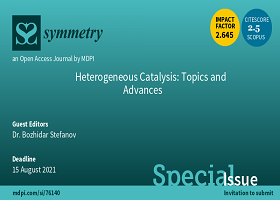Heterogeneous Catalysis: Topics and Advances
A special issue of Symmetry (ISSN 2073-8994). This special issue belongs to the section "Chemistry: Symmetry/Asymmetry".
Deadline for manuscript submissions: closed (31 October 2022) | Viewed by 26450

Special Issue Editors
Interests: photocatalysts; thin films; sol-gel deposition; computational modeling; FTIR; Raman spectroscopy; photoelectrocatalysis; photodeposition; functionalization of photocatalysts; optical properties; optical modeling of thin films
Special Issues, Collections and Topics in MDPI journals
Interests: electrocatalysis; electrochemical ammonia synthesis; direct ammonia fuel cell; high entropy alloys; solar water splitting; electrochromism
Interests: heterogeneous catalysis; complete oxidation of volatile organic compounds; in situ infrared spectroscopy; characterization of new catalysts by different methods (FTIR, TPR, solid-state NMR, XRD, XPS, and adsorption); catalysis of supported metal on porous materials
Special Issues, Collections and Topics in MDPI journals
Special Issue Information
Dear Colleagues,
Heterogeneous catalysis has seen a surge in academic interest due to its important applications, such as renewable-energy conversion, environmental remediation, organic products synthesis and transformations, green catalysis, and many others. Although unnoticed on its own, symmetry and its implications is often a main topic of research in the field of catalysis. Hence, this Special Issue of Symmetry is dedicated to the theme “Heterogeneous Catalysis: Topics and Advances.”
The issue is open to submissions covering any aspects of heterogeneous catalysis, fundamental or practical. Special attention will be paid to research, focused on the the implications of symmetry in catalysis, such as (but not limited to): effects of crystallographic structure, shape and orientation on catalytic activity; effects of substrate symmetry in catalysis; symmetric/asymmetric activity and reaction pathways in catalysts; effects of support morphology and structure on catalytic activity (e.g., photonic effects in photocatalysts supported on highly-ordered substrate), etc.
Dr. Bozhidar Stefanov
Dr. İlknur Bayrak Pehlivan
Dr. Silvia Todorova
Guest Editors
Manuscript Submission Information
Manuscripts should be submitted online at www.mdpi.com by registering and logging in to this website. Once you are registered, click here to go to the submission form. Manuscripts can be submitted until the deadline. All submissions that pass pre-check are peer-reviewed. Accepted papers will be published continuously in the journal (as soon as accepted) and will be listed together on the special issue website. Research articles, review articles as well as short communications are invited. For planned papers, a title and short abstract (about 100 words) can be sent to the Editorial Office for announcement on this website.
Submitted manuscripts should not have been published previously, nor be under consideration for publication elsewhere (except conference proceedings papers). All manuscripts are thoroughly refereed through a single-blind peer-review process. A guide for authors and other relevant information for submission of manuscripts is available on the Instructions for Authors page. Symmetry is an international peer-reviewed open access monthly journal published by MDPI.
Please visit the Instructions for Authors page before submitting a manuscript. The Article Processing Charge (APC) for publication in this open access journal is 2400 CHF (Swiss Francs). Submitted papers should be well formatted and use good English. Authors may use MDPI's English editing service prior to publication or during author revisions.
Keywords
- heterogeneous catalysis
- catalysts structure-activity relationships
- symmetric and asymmetric activity in catalysts
- shape-selective synthesis of catalysts
- catalyst support structure effects on activity
- photonic effects in photocatalysis
- molecular symmetry effects on catalytic activity
Benefits of Publishing in a Special Issue
- Ease of navigation: Grouping papers by topic helps scholars navigate broad scope journals more efficiently.
- Greater discoverability: Special Issues support the reach and impact of scientific research. Articles in Special Issues are more discoverable and cited more frequently.
- Expansion of research network: Special Issues facilitate connections among authors, fostering scientific collaborations.
- External promotion: Articles in Special Issues are often promoted through the journal's social media, increasing their visibility.
- e-Book format: Special Issues with more than 10 articles can be published as dedicated e-books, ensuring wide and rapid dissemination.
Further information on MDPI's Special Issue polices can be found here.







